| Cassino
'44:
A Virtual Battlefield Tour
By Dave Murray
May 2012
The Panzer
Grenadier game Cassino ’44 has a map representing the mountains and
the valleys of the Cassino area of Italy
as it appeared during the dark months of
early 1944. Cassino ’44 covers the
battles on the Cassino massif as well as
down in the valley and villages of the Liri
Valley.
In today’s Daily Content we survey
the major features of the battlefield and
discuss their role and significance in refighting
this most intense of battles.
The Monastery of Monte
Cassino
The most famous landmark on the Cassino
map is of course the monastery of Monte Cassino.
This massive structure, built to withstand
wars and earthquakes, had walls of stone
up to 10 feet thick. The monastery, perched
on the Cassino massif commanding views of
the Liri Valley, became a fixation for the
allied soldiers exposed in the valley below
or hanging on to the barren surface of the
surrounding mountains.

On the Cassino ’44 game map the abbey
just fits within a single hex. The destruction
of the abbey in February 1944 remains to
this day a controversial decision. The German
soldiers in the area have always maintained
that no troops were located in the monastery
prior to the bombing, a fact corroborated
by the monks and abbot. However, German troops
were placed into positions ever closer to
the monastery as the Allied attacks forced
the German’s back. Whether the Germans
would ever have occupied the monastery when
pressed we will never know, but hindsight
seems to have judged the allied bombing of
the monastery harshly considering the imperatives
of the time, misguided or not. Whatever the
original German intentions were, they soon
occupied the ruined monastery and turned
it into a veritable fortress.
The monastery was never taken by the Allies
in battle. It was only when the German fallschirmjager’s
(paratroopers) defending the ruins withdrew
on the night of the 17th May that the Polish
12th Lancers were able to take the ruins.
On the morning of the 18th May they hoisted
their improvised flag over the ruins.
In Cassino ’44 the monastery appears
as a victory location in many of the scenarios
and of course both campaign games. The monastery
is the single most valuable object on the
map and is worth more victory points than
any other single feature. It is a formidable
building to capture, surrounded on five sides
by steep slopes. The ruined monastery has
the same characteristics as an entrenchment
and an increased stacking limit, making all
assaults extremely difficult.
During playtesting it was a rare occurrence
when the monastery fell in an assault. The
Cassino specific rules make all bombardment
fire on the massif affect adjacent friendly
forces on a roll of 1 or 2, which makes close
artillery support risky. Taking the monastery
requires patience, good leadership, strong
infantry forces, artillery support and tank
support if you can get it there! In the campaign
games often the defenses were so strong that
the monastery was bypassed by advancing units
and then mopped up later.
Castle Hill: Rocca Janula
The ruins of the medieval castle sitting
directly above the town of Cassino were of
major tactical significance. Known by the
Allies as Castle Hill, it was surrounded
on five sides by steep cliffs and was a very
formidable objective.
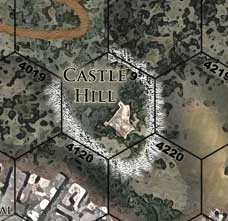
Historically the castle was briefly taken
by U.S. soldiers in January and then later
on the evening of 12th March by New Zealanders
of D Company, 25th Battalion. A platoon scaled
the cliffs and caught the sentries by surprise,
then took out a pillbox. When the rest of
the company, who had skirted around the cliffs
to the west, arrived they forced the remaining
Germans into the castle itself. After a brief
firefight the Germans surrendered.
The castle is a significant feature in the
game. Units occupying it can cover most of
the northern end of the town of Cassino with
plunging fire. Control of the castle also
opens up access to the road that snakes its
way up to the monastery. The exposed nature
of the castle is both a benefit and a problem;
it commands the surrounding lower hexes but
is an easy target for Allied armour in the
valley below. Using sufficient artillery,
direct fire and armour support it is not
that unlikely that the allies can suppress
the German defenders, but getting foot soldiers
close enough to take advantage of the situation
for the Allies is difficult. A good German
leader and HMG squad can cause considerable
difficulties for any Allied troops advancing
along the valley road from the north.
In the campaign games Castle Hill is second
only to the monastery for victory points.
It is a feature that is really difficult
to avoid either for the defender or the attacker.
With hindsight it is unlikely the Allies
will be able to surprise the Germans as happened
historically, and the fight for the Castle
can consume a lot of resourses for both sides.
Castle Hill is a significant victory location
in many of the scenarios in Cassino ’44.
The initial American assault attempted to
capture the northern edge of Cassino town
and Castle Hill but found the going too difficult
and costly and quickly switched to operations
on the massif itself.
The New Zealand Corps are involved in several
battles that include the castle as a key
victory location. The Germans knew the importance
of the castle’s location and launched
a major counter attack on the morning of
March 19. This action is represented in Scenario
18, “The Castle Must Fall.”
The Rapido River
On the maps of the Liri Valley the Rapido
River appears quite benign, a small ribbon
of blue across an open valley and the route
to Rome. The reality was very different,
as the brave men of the 36th “Texan” Division
found on the tragic night of January 20 when
their attempted crossing went disastrously
wrong.

The Rapido is very fast flowing with near-vertical
soft muddy banks, and although only 30 to
50 feet wide it is up to 12 feet deep. Couple
this with heavy winter rains that waterlogged
the surrounding farmland and the Germans’ flooding
of the area and you end up with treacherous
terrain only approachable by soldiers on
foot.
The Rapido was a central part of the formidable
Gustav line of defences that stretched across
the Italian mainland from coast to coast.
The Germans had extensively mined and wired
the east bank of the river. Strongpoints
and extensive fire plans covered the eastern
approaches to the Rapido.
In game terms crossing the Rapido is difficult
for the Allies. The American forces were
given the initial task of breaching the river
defences and the first couple of scenarios
cover these assaults. The U.S. campaign offers
the Allied player the opportunity to attempt
to breach the Rapido at alternative locations
and try some different strategies.
There is nothing subtle about breaching
the Rapido; the U.S. forces must push hard
and accept the inevitable mounting casualties
from such an operation. The British forces
face the same problem later during Operation
Diadem. The Germans are in a strong defensive
position, but the amount of firepower the
Allies can call upon means the German player
must use his forces wisely. The defenders,
if not used carefully, will quickly see the
defence haemorrhaging and the Allies making
significant progress.
The German player must try to absorb the
Allied onslaught, causing as many difficulties
to them as possible while keeping their own
forces in as good a condition as possible.
A skilful defence can see the Allies reaching
a point of exhaustion, and then a counter-attack
can split the attackers wide open. In the
campaign game in particular, a successful
German counter-attack towards the Allied
bridgehead can cause considerable delay to
the Allies, as well as potentially isolating
forces to the west of the Rapido. Isolated
forces suffer a drop in their morale.
Cassino Town
Highway Six, the ultimate objective for
the Allies and their dreams of marching up
the Liri Valley towards Rome, runs through
the town of Cassino. This means there can
be no victory without control of the town.
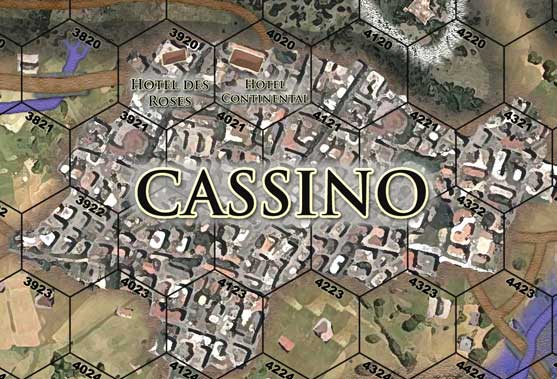
The Americans in early February reached
the northern edge of the town (north is to
the right). The German defenders were very
well prepared; Cassino town was probably
the strongest element in the whole of the
Gustav Line defences. The Americans, unable
to make sufficient progress, quickly switched
to fighting on the massive itself.
The destruction of Cassino town by Allied
bombers on March 15th heralded the New Zealand
Corps assault on the town. The bombing of
the town was a double-edged sword for the
New Zealanders. The bombing devastated the
town and nearly completely eliminated the
German defenders who suffered horrendous
casualties, but the defenders were not ordinary
soldiers; they were the elite Fallschirmjager,
the remnants of which quickly regained composure
and mounted an astounding defence.
The narrow streets of Cassino were clogged
with rubble and huge craters meant that the
armoured support of the New Zealanders was
incapable of supporting the advancing infantry.
The progress of the New Zealand troops was
slow and costly. The battle for Casino town
continued for two more months before the
German defenders finally surrendered.
Cassino town has two significant features
marked on the map, Hotel Continental and
Hotel Des Roses. Hotel Continental was a
very formidable defensive position for the
defending Fallschirmjagers; they had backed
a Panzer IV into the lobby of the hotel to
make it the strongest position in the town.
The hotel was never taken by the Allies.
It fell only after being abandoned by the
Germans after the British and Poles had broken
through the Gustav Line to the west. The
Hotel Des Roses, although not as formidable
as the Continental, was a strongpoint and
units within it gain dug-in benefits.
Cassino ’44 provides rules for both
before and after destruction of the town.
Due to the extensive German defences, German
Fallschirmjagers retain the ability to withdraw
from an assault without a “free shot” against
them.
The town is a tough nut to crack for the
Allies; many scenarios cover the fighting
in and around the town. In the campaign,
deciding how many resources to allocate to
taking or defending Cassino can be a very
tough decision. During playtesting, a “Cassino
only” strategy during a campaign proved
a very difficult strategy to succeed in,
similar to the experience of the New Zealanders
that attempted the same strategy 64 years
before. The front on which you can press
an attack is very narrow and favours the
defender. But neither can the Allies ignore
the town as it is a large source of victory
points. Allied success in other areas of
the front can cause the Germans to thin the
defences in the town and then a significant
allied push may result in its capture.
Monte Villa Barracks
This large complex of buildings on the road
north of Cassino town was of obvious tactical
importance for any forces trying to cross
the Rapido north of Cassino town.
The barracks, formally occupied by the Italian
army, had provided an important defensive
position for the German defenders. Any forces
crossing the Rapido in this sector would
need to capture the barracks in order to
open up the road to Cassino town.
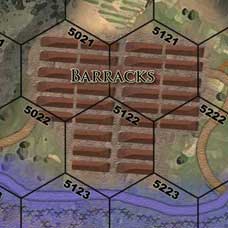
After the disastrous attempts of the U.S.
36th Division in crossing the Rapido to the
south the 34th Division crossed the Rapido
opposite the barracks. Several scenarios
cover these attacks but ultimately all these
attacks failed. A few days later an easier
crossing location was discovered a little
further to the north and that crossing proved
successful. The barracks were still needed
to be taken in order for forces to funnel
down the road towards Cassino town. The barracks
held for a couple of days the Germans only
retreating after the U.S. forces were swinging
around them from Point 213.
In game terms it can serve as an early
defensive position, but once the Allies
are across the Rapido in strength it is
easy for the position to become isolated.
Knowing when to withdraw is crucial.
The Liri Valley
Opening the Liri Valley and the route to
Rome was the key objective of the Cassino
campaign. It was not until Operation Diadem
in May that substantial inroads into the
valley took place. The Germans fought a skilled
defensive action, deploying a small number
of tanks when required.
In one such action in May 1944, Francis
Jefferson of the 2nd Battalion of the Lancashire
Fusiliers earned the British armies highest
decoration in the valley below Monte Cassino.
From his official citation: “On 16th
May, 1944, during an attack on the Gustav
Line, an anti-tank obstacle held up some
of our tanks, leaving the leading company
of Fusilier Jefferson’s battalion to
dig in on the hill without tanks or anti-tank
guns. The enemy counter-attacked with infantry
and two Mark IV tanks, which opened fire
at short range causing a number of casualties
and eliminating one PIAT (Projectile Infantry
Anti-Tank) group entirely. As the tanks advanced
towards the partially dug trenches, Fusilier
Jefferson, entirely on his own initiative,
seized a PIAT and running forward alone under
heavy fire took up a position behind a hedge;
as he could not see properly he came into
the open and standing up under a hail of
bullets fired at the leading tank which was
now only twenty yards away. It burst into
flames and all the crew were killed. Fusilier
Jefferson then reloaded the PIAT and proceeded
towards the second tank, which withdrew before
he could get within range. By this time our
own tanks had arrived and the enemy counter-attack
was smashed with heavy casualties. Fusilier
Jefferson’s gallant act not merely
saved the lives of his company and caused
many casualties to the Germans but also broke
up the enemy counter-attack and had a decisive
effect on the subsequent operation. His supreme
gallantry and disregard of personal risk
contributed very largely to the success of
the action.”
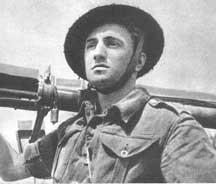
Francis Jefferson
Railway Station and
the Hummocks
To
the south of Cassino town stands the railway
station with its distinctive “round
house” and low hummocks to the south.
The railway line was built on a low embankment.
The Germans had blown large breaches in
the embankment in order to stop the Allies
using it for their armour. The railway became the focus of the battle
on the night of February 17. Two companies
of the 28th New Zealand “Maori” Battalion
crossed the river and captured the railway
station. Behind them engineers worked through
the night to repair the breaches in the embankment.
The Maoris had captured the railway station
but the hummock stayed in German hands. By
the morning all but one breach in the embankment
was repaired but with the approach of daylight
German shelling forced the engineers to halt
work. The Maoris, with no armour support
or anti-tank guns, held on for most of the
day but were eventually forced back across
the river.

The actions around the station are represented
in two scenarios, one covering the Maoris
night attack on the 17th and one the German
counter-attack on the 18th. In the campaign
games the observation of this position by
the Germans on the massif makes any successful
crossing here very difficult. The Germans
can quickly dispatch forces from Cassino
town to assist in repelling the attacks.
With Cassino town on the brink of collapse,
capture of the railway station and the hummocks
can lead to a knockout blow for the defenders,
as long as you are keeping the Germans on
the massif busy as well!
Snakeshead Ridge
To the northwest of the monastery lies a
ridgeline the Allies called Snakeshead Ridge.
Snakeshead Ridge dominates the approaches
to the monastery from the mountains. At the
southern end of the ridge is Point 593, a
most significant feature as this commands
the approaches to the monastery itself.
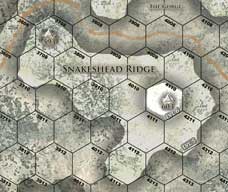
The battle for control of Snakeshead Ridge
is really the battle for Point 593; the point
was captured by the Americans, Indians and
Poles only to lose it again to fierce German
counter-attacks.
The art of defending on the massif is the
use of the counter-attack. During playtesting
a German reserve on a reverse slope, able
to counter attack after the attackers had
almost exhausted themselves, won many victories
and could snatch the location back from the
allies at the last moment. (For campaign
games the Allies need to solely control key
features such as point 593 on the massif;
if the Germans can contest the locations
at the end of day’s battle they retain
control.) The difficulty for the German is
when to counter. Go too soon and you will
suffer unacceptable losses, leave it too
late and victory will slip through your hands.
Cavendish Road
The construction of the Cavendish Road was
a substantial task. During late February
and early March, Indian engineers had in
secret improved an old mule track that snaked
its way up the mountains from the village
of Cairo to high ground around Albanta Farm.
Most of the work was undertaken at night
with large stretches of camouflage netting
obscuring any German observation during the
day.

The intent was to surprise the Germans on
the mountains with a sudden armoured thrust
in an area in which they thought armour could
not penetrate. This armoured attack was to
take place simultaneously with a strong infantry
attack from Cassino town. The tanks moved
into position and attacked on March 19.
From the start things did not go well. That
morning the Germans had launched an assault
on Castle Hill which had disrupted the planned
Allied infantry attack, but apparently no
one told the Allied tanks on the Cavendish
Road! The tanks launched their attack and
succeeded in surprising the Germans on the
mountain, but the Fallschijager were no ordinary
soldiers and quickly recovered. Substantial
small-arms fire forced the tanks to button
up and the Germans closed, taking out several
tanks with anti-tank grenades.
Cavendish Road was very narrow and manoeuvring
around knocked-out tanks while buttoned up
proved very treacherous. Several tanks threw
their treads in the process. The tanks with
little infantry support continued to struggle
forward, but by the time they reach Albaneta
Farm German anti-tank fire and mines caused
the attack to be abandoned.
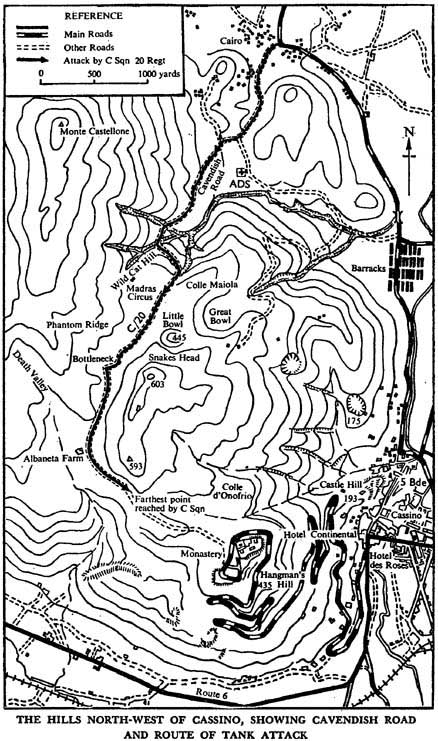
Sant’ Angelo
Sant’ Angelo is a small village on
the west bank of the Rapido River in the
centre of the Liri Valley. Its position at
the centre of the Liri Valley meant that
Sant’ Angelo was an important strategic
location.
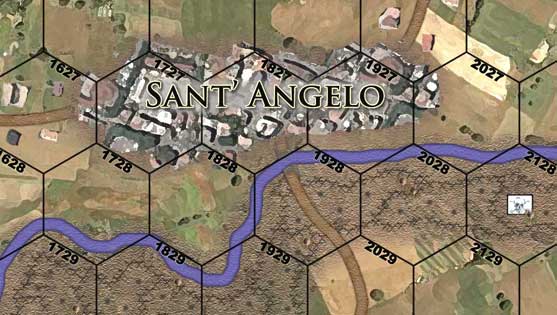
The initial attempt to breach the Gustav
line was undertaken to the north and south
of Sant’ Angelo on January 20 to 22.
The U.S. 36th “Texas” Division
attempted a night crossing but the attack
was a disaster. The attack after the war
was subject to a Congressional Enquiry which
eventually exonerated General Clark, the
commanding officer at the time. After the
failed U.S. attack across the Rapido near
Sant’ Angelo in January, this area
of the front was relatively undisturbed until
the start of Operation Diadem in May.
On the morning of May 11, after a night
time artillery barrage, the 8th Indian Division
attack across the Rapido at Sant’ Angelo.
In thick fog the Frontier Force Regiment
attacked to the left of the town and the
1st Royal Fusiliers to the right. Fighting
was fierce and it was not until the 13th
that a hastily-constructed bridge allowed
several Canadian Shermans to cross the river
and, supported by Ghurkha troops, finally
cleared Sant’ Angelo of Germans.
Cairo
The village of Cairo or “Caira” is
nestled in the hills below Monte Castellone.
After the failure of the Rapido crossings
of January 20 the U.S. forces changed their
axis of attack to the Rapido as it runs to
the north of Cassino town.

The initial attacks against the barracks
area were not successful. On January 27 General
Ryder committed the 168th regiment of the
34th U.S. Division to attack north of the
Barracks. This attack proved successful and
within four days the village of Cairo was
captured and remained under Allied control
for the rest of the campaign.
Pignataro
Pignataro strides across the road that stretches
across the Liri valley from north to south
and so control of it was strategically very
important.
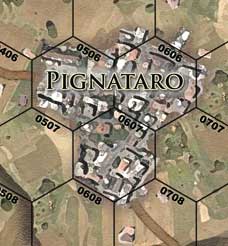
The German had located several Nebelwerfer
of the 71st Werfer Regiment in the village
and these had by early May been causing the
Poles on Cassino Massif a lot of problems.
On the evening May 15, elements of the 3/8
Punjab Regiment supported by the 14th Canadian
armoured closed in and took the village,
but the Nebelwerfer had already been moved.
Horseshoe Ridge
In the flatlands of the Liri Valley, minor
rises and small hills become significant.
To the west of the village of Sant’ Angelo
a horseshoe shaped hill became a significant
defensive position in the spring of 1944.
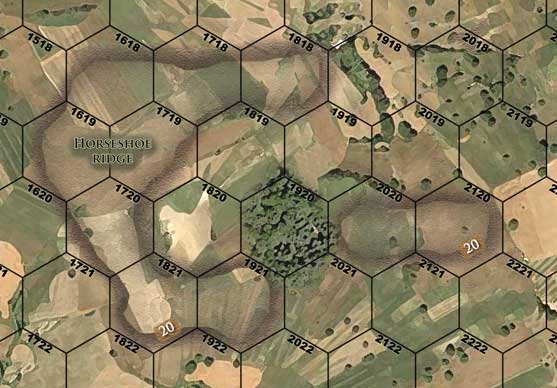
The ridge finally fell on May 13 with the
village of Sant’ Angelo.
Hangman’s Hill
Hangman’s Hill is a large rocky outcrop
below the monastery of Cassino. Because of
its prominence and proximity to the monastery
it became a key feature in the planning of
many assaults. The rather gruesome nickname
of “Hangman’s Hill” referred
to the remains of a cable car support—the
car used to run from the valley to the monastery—which
resembled a gallows.
Despite it being the target of many assaults
on the massif, the capture of Hangman’s
Hill came as a surprise to the Allied commanders.
On March 19 a hitherto thought lost group
of the 1/9th Gurkhas appeared on the hill.
Over the next couple of days the Allies tried
to resupply the Gurkhas first on foot and
then by air. The Germans made the Gurkhas’ stay
on the hill very uncomfortable. Eventually
it proved too difficult even for the hardy
Gurkhas and they abandoned their position.
Scenario 17 represents the attempt by the
Rajputanas to supply the Gurkhas.
Albaneta Farm
High up in the mountains is a small farm
complex. The ancient farm buildings had thick
stone walls and proved a substantial defensive
position.
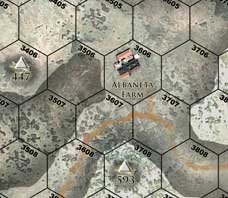
The farm in the shadow of Point 593 and
adjacent to the ‘Cavendish Road’ saw
much action during the campaign. The US 142nd
Regiment was stopped short of the Farm on
the 11th February. During the armoured attack
along the Cavendish Road on the 19th March
the Farm was a major defensive base for the
defending German paratroopers.
The Poles eventually managed to secure the
Farm in mid-May.
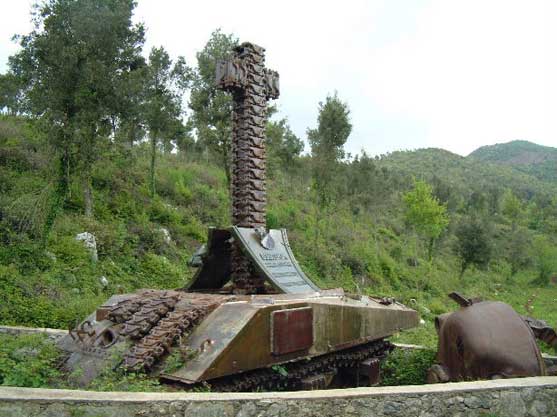 Polish Memorial at Albaneta Farm Polish Memorial at Albaneta Farm
Point 175
Point 175, like so many of the minor summits
and features of Cassino massif was fought
over by all sides during the campaign. However,
on February 8, 1944, at Point 175, just northwest
of Cassino town, Second Lieutenant Paul F.
Riordan from Kanas City, cut off from his
unit, single-handedly led an attack on an
enemy strongpoint. He postumously earned
the U.S. highest military award, the Medal
of Honor.
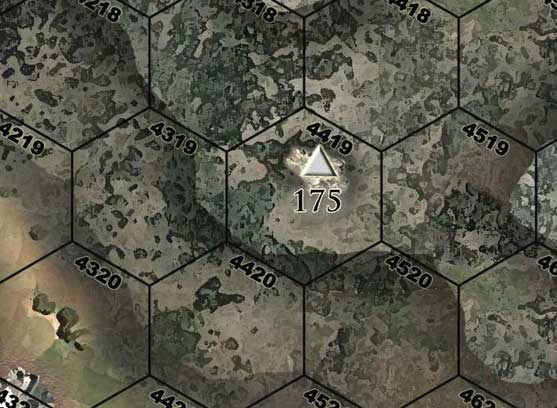
The Medal of Honor citation reads:
For conspicuous gallantry and intrepidity
above and beyond the call of duty. In the
attack on the approaches to the city of Cassino
on 3 February 1944, 2nd Lt. Riordan led one
of the assault platoons. Attacking Hill 175,
his command was pinned down by enemy machinegun
fire from the hill and from a pillbox about
45 yards to the right of the hill. In the
face of intense fire, 2nd Lt. Riordan moved
out in full view of the enemy gunners to
reach a position from where he could throw
a hand grenade into the pillbox. Then, getting
to his knees, he hurled the grenade approximately
45 yards, scoring a direct hit. The grenade
killed one and wounded the other two Germans
in the nest and silenced the gun. Another
soldier then cleaned out the enemy pillboxes
on the hill itself, and the company took
its objective.
Continuing the assault into Cassino itself
on 8 February 1944, 2nd Lt. Riordan and his
platoon were given the mission of taking
the city jail house, one of the enemy's several
strongpoints. Again 2nd Lt. Riordan took
the lead and managed to get through the ring
of enemy fire covering the approaches and
reached the building. His platoon, however,
could not get through the intense fire and
was cut off. Second Lt. Riordan, aware that
his men were unable to follow, determined
to carry on single-handed, but the numerically
superior enemy force was too much for him
to overcome, and he was killed by enemy small-arms
fire after disposing of at least two of the
defenders. Second Lt. Riordan's bravery and
extraordinary heroism in the face of almost
certain death were an inspiration to his
men and exemplify the highest traditions
of the U.S. Armed Forces.
See
if you can match the exploits of Riordan
and Jefferson!
Order
Cassino
'44 today. |


